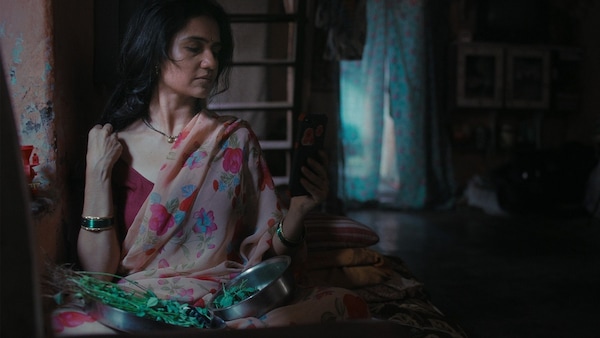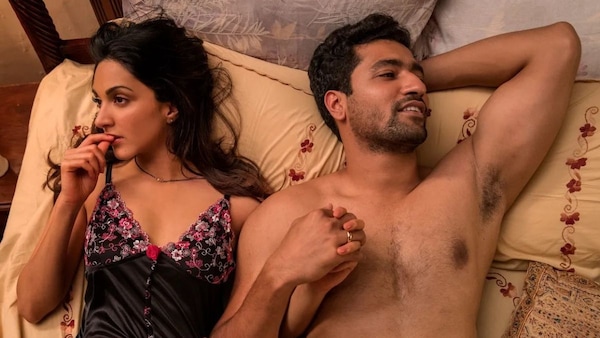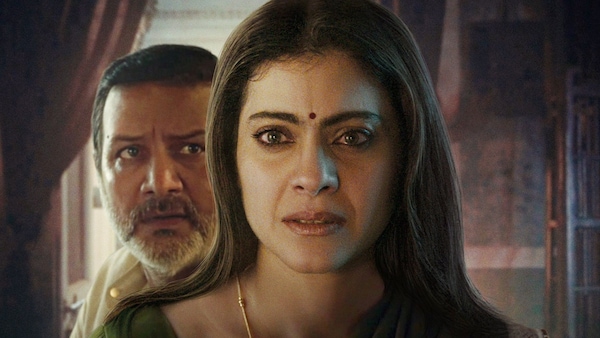Lust Stories 2: One Terrific Short In A Sea Of Mediocrity
This is #CriticalMargin, where Ishita Sengupta gets contemplative over new Hindi films and shows. Here: Lust Stories 2 on Netflix.

Last Updated: 07.15 PM, Jun 29, 2023
Spoilers ahead.
TO know lust is to acknowledge it. Hindi films, not unlike pop culture, have a tendency to portray it as an adjective — a verb even — and not a noun. Which is to say, that the emotion is never really depicted for what it is. Instead, it is used to describe a person (“lusty”) or an act (“lusting”), thus narrowing something which is inherently universal. The first edition of Lust Stories, a 2018 Netflix anthology helmed by a diverse group of filmmakers like Anurag Kashyap, Zoya Akhtar, Dibakar Banerjee and Karan Johar, was an attempt to outline the nature of lust by stressing on its ubiquity. That all four shorts were headlined by women with their desires forming the narrative crux only accentuated the forbiddenness of the theme in hand. It was a largely competent outing that gained from the singular perspectives of the makers.
In comparison, Lust Stories 2 is a flat out inferior series, preoccupied with diluting the emotion by making excuses for it. For the most part, its understanding of lust is so painfully reductive that it yields stories that encourage neither attentive watching nor ingenious reading. All save one. More on that later.
The roster provides some clues: R Balki, Konkona Sen Sharma, Sujoy Ghosh and Amit Ravindernath Sharma are the filmmakers this time. On paper, this is an eclectic bunch, wide-ranging in their narrative interests. This, automatically, opens up exciting possibilities, prodded by the sheer prospect of genre directors working in a new format with an overarching theme. The sad bit is two among them use gimmick as a shorthand for inventiveness: Balki and Ghosh.

Balki’s Made for Each Other opens the anthology. Veda and Arjun (Mrunal Thakur and Angad Bedi) are about to get married. Their fathers are friends who reconnected after 12 years. This resulted in the kids meeting and liking each other. They have things in common: they both like Chinese food, Sufi music. Both are as ambitious as the other. There is no conflict except one: Veda’s god-loving grandmother (Neena Gupta). On the day the families meet, the old woman drops the S word. Do they have sexual compatibility, she asks, leaving everyone red-faced.
Balki’s film is what can broadly and only be described as “quirky”. Sure it is: an old woman, who spends most of her time praying, openly talks about the importance of sex, putting her son to shame. But if Balki’s career is any proof, his outings begin and end as empty iterations of quirks. This is no different.
The film unfolds as a classic case of two men (Balki and Rishi Virmani are credited with the screenplay) choosing to center their story on the female orgasm without having any clue about what it is. Gupta’s character drops the S-word twice every five minutes but Balki never depicts it. Veda and Arjun meet, get horny, storm into hotels. And then, the doors close on our faces. This strangely sanitised approach speaks less of an artistic decision and more of the maker’s inadequacy to walk the talk.
It is also a distinct Balki problem where his one-line ‘quirky’ premise (house-husband and working-wife; old man in love with a young woman; an old religious woman unafraid of talking about sex) is expected to tide the film through. There are other thorny issues. The filmmaker treats the short as a full-length feature film (all problems, nursed through decades, are magically solved after two monologues by Gupta’s character). His rendering of lust is so stilted that it almost feels like a staid academic equation which, he insists, can be solved like this: Lust = Sex.

Veda’s grandmother eggs her on to have sex with Arjun before marriage. They do, but she does not come. They keep at it till she does (I could almost hear her preface this with “Some personal news”). But the outing treats this with such surface-level redundancy and male panicky energy that something as urgent as female orgasm, and the lack of it, become a punchline. For instance, we are not told if this is the first time Veda has had an orgasm, or what transpired when she did not come with Arjun for the first time. Did he hear her out? Or, was the sex later so good that there was no need to talk? Where is the lust? Where is the story?
No less baffling is Ghosh’s Sex with Ex which unravels as a bizarre piece of filmmaking that treads on artifice and contrivance. Designed as a story about revenge, it focuses on Vijay (Vijay Varma), a slimy man who channels his charm to further his ambition. When we meet him, he is driving a vintage car and nudging a girl over video to strip for him. He is going to meet her and she is teasing him with only one piece of clothing left on her body. In the midst of this, he gets a call from someone in his office (Jugal Hansraj) to come back urgently. The big boss, also Vijay’s father-in-law, has called for an emergency meeting. Something in his face changes. He keeps the girl on hold and makes another call. A young boy greets him with “papa” and then another woman talks to him, her unhappiness evident even over a video call. She will attend the meeting, she says, even if that might seem like doubting her husband’s intention. The other girl is getting impatient now. Vijay tells her he has to go as she clutches onto the only thing she still has on: a bra. She takes it off and he loses control of his car.

Back in 2015, Ghosh had made a short called Ahalya, a kooky little film about lust and desire. It was fun and buoyant and could have been a better addition to the Lust Story anthology than his present work. His recent one is too clunky, plotty and unfolds as a description of lust rather than an exploration of it.
After Vijay slams his car, he is forced to get down at a strange little town. The sky looks more pink, the air feels different. Not to Vijay, who quickly moves to repair his car and fetch coffee. In this surreal setting he finds a woman orchestrating a choir (they are singing the song, “Jab Koi Baat” from the 1990 film Jurm). She turns and their gaze meets. They know each other. Shanti (Tamannaah Bhatia) is his first wife. Ten years back she had disappeared one day and never returned. She was feared to be dead so Vijay married their common friend.
Ghosh’s outing makes for a better story on paper. When translated on screen, it unfolds as a peculiar rendition of lust with the filmmaker choosing to depict the new sexiness of Shanti 2.0 through heavy-handed literalness. For instance when they make out again, Vijay looks at her breasts and asks, “Were they always like this?” or when she goes to take a bath and he fishes out her bra to check the size (36 DD, of course). Granted he uses the theme to present a tale of retribution but the ridiculousness of the premise never holds up (a lot of things give it away, for one: the pink sky) as it plays out more as a reiteration of the male gaze than a critique of it.
In that sense, Sharma’s outing feels less abstract. He sets his film in a dying world of kings with lost crowns. Devyani Singh (Kumud Mishra) is an alcoholic abuser. Years of privilege and entitlement have convinced him whoever he touches can be his. His wife (Kajol) is a victim of circumstances. Her last attempt at freedom (she is a former sex worker) resulted in a life of captivity. She has pinned her hopes on her son to get out of the rut and take her too.
Tilchatta takes a while to come together. For the most part the short is one twist folded into another, threatening to spurt out instead of untangle. Granted, the revelation at the end can be anticipated from a mile away. But what works for the film is the cognisance with which it acknowledges the cruciality of lust and the slipperiness of it. He is only the second filmmaker in the group who expresses some curiosity over lust and does not restrict it to an act.

This brings me to the finest short of the series: Konkona Sen Sharma’s The Mirror. The Tillotama Shome and Amruta Subhash starrer is so terrific that it transcends the bindings of the anthology. The utter flawlessness of the film is best evidenced in the way it matches the porosity of the theme with the plurality of its premise.
Isheeta (Shome), a working professional, lives in an upscale flat in Mumbai. One day a bout of migraine attack forces her to come home early. On unlocking her house, she finds a guest in the bedroom: her domestic help having sex with a man. She is repulsed — like someone has dunked her in grime. She says nothing, but washes the bedsheets. Soon, the feeling is replaced with curiosity and then unsated eagerness. Isheeta starts coming home at 3 pm in the noon and makes a habit of touching herself while watching them through the mirror.
Sharma’s work is so masterful that it opens itself up for multiple readings. The Mirror at once is a depiction of urban loneliness, class privileges, codependency sustained by modern-day living, a clear-eyed examination of gender, and a course-correction in the discourse of desire which recognises lust through a specific parameter of bodies. All of these are held together by an ever volatile power dynamic that changes positions like a manifestation of lust itself.
In more ways than one, the film is reminiscent of Bong Joon-ho’s Parasite in its acuity of class distinctions but it is also very much a beast of its own. It is truly a marvel the way the filmmaker uses the presence of gaze, making it difficult to discern who is the voyeur and who is the exhibitionist. The fluidity of the arrangement also makes the one who is catching feel like being caught.
The Mirror, by far, is the best short in the anthology. It is also one of the best fictional works of the year so far. Sharma’s understanding of the subject is profound, her use of space is unmatched. But more importantly, she understands that at the most fundamental level, all lust stories have one thing in common: the presence of three.
(Disclaimer: The views expressed in this column are those of the author and do not necessarily reflect the official policy or position of OTTplay. The author is solely responsible for any claims arising out of the content of this column.)

